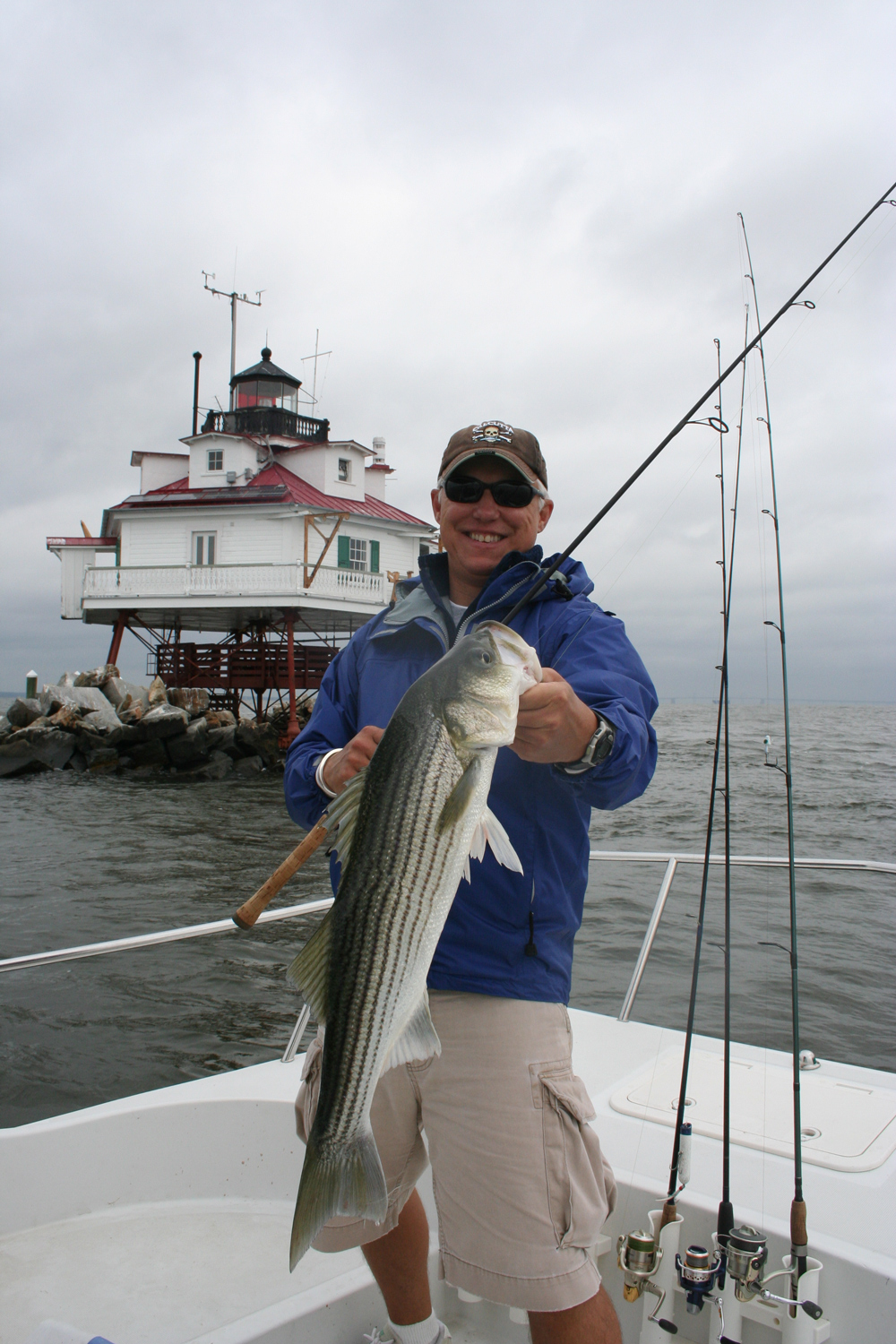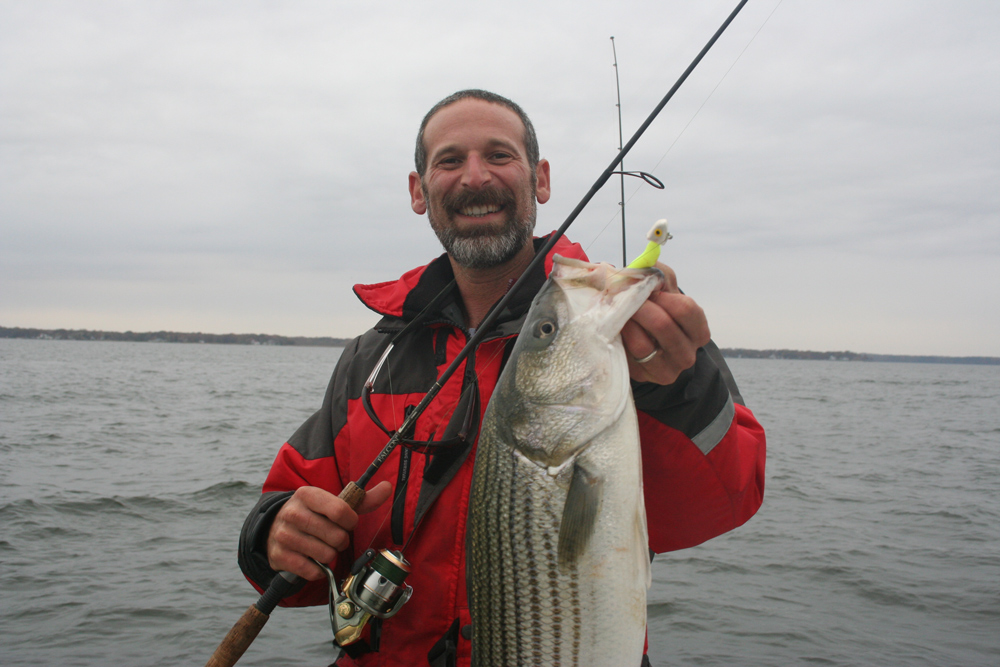Stripers are one of the most popular fish in the Mid-Atlantic region (which is why we have so darn many striped bass fishing articles on FishTalk), but why do stripers act the way they do? How do they see things from their perspective? And what biological traits do they have that we fishermen need to know about? Getting inside the fish’s brain will go a long way to helping you catch more, bigger rockfish. Get a handle on these five key attributes of striped bass, and you’ll gain significant insight into how, why, and when they feed the ways they do.

1. Eye Candy – Hold up a 36” striper, and look at its eyes. Yes, they’re nearly as large as your own eyes even though the fish is a mere fraction of a human’s size. This is the first and one of the most important features you should always bear in mind, when you’re targeting stripers — these fish are designed to hunt most effectively in low-light conditions. In fact, experienced night-fisherman know that the catch is often much better after the sun has dropped below the horizon. So, why do so many of us catch so many fish in broad daylight? Because that’s when 99-percent of us focus our efforts. If everyone fished in the dark instead, our coolers would overflow more often. Even better than darkness, however, is fishing during periods of changing light. This is when a baitfish’s eyes aren’t fully adjusted to the shifting brightness or dimness, and stripers find hunting most productive.
This explains why sunrise and sunset often offer the hottest bite of the day. More good light shifts are caused by intermittent rain, relatively heavy cloud cover, and shade lines around structure. Even when night fishing for striped bass it’s the transitions that often provide the hottest action; look for breaks in light-lines, where artificial light disappears into the darkness or bright moonlight is broken by shadows.
2. Zebra Fish – The lines across a striper’s flanks may look uniform to us, and maybe even seem to advertise the fish’s presence. But we’re looking at them through the air — not through water. Beneath the surface, those stripes interrupt the fish’s body shape whenever reflected light shimmers off of the bottom or an object. Light bounces all around when it strikes the uneven surfaces crated by rockpiles and jetties, for example, which explains why stripers like hunting around these types of structure. It also explains the fish’s nickname, rockfish, because you always seem to find them wherever there are rocks around.
Yes, of course you also find stripers suspended, roving in schools, busting the surface. But as a general rule of thumb, structure is an imperative item to these fish. What does this mean to you, as an angler? Expect to find rockfish extremely close to structure, when they are oriented to it. If you cast within 10 feet of a rip-rapped point, for example don’t think that’s good enough – get a cast or two within a foot of those rocks. If you’re trolling past bridge pilings, don’t accept a 20’ distance between your boat and the concrete – drag those lines just as darn close to the pilings as you dare. And if you’re vertically jigging over a wreck, don’t guess at the depth your lure is at. Instead, keep dropping as you jig to ensure your offering is within inches of the structure.

3. Sandpaper Mouth – Grab a striper by the jaw, and you can feel those sandpaper-like teeth. Why don’t have sharpies like a bluefish? Or conical teeth, like a tuna? And as an angler, why should you care? There are some biological advantages to the striper’s type of teeth. They allow for sucking in pray of all different types, from fish to clams to worms. They’re good for crushing instead of chopping, thus not losing sections of the chopped prey as it drifts away or is stolen by competitors. And these sandpaper teeth aren’t prone to injury.
As an angler, what you need to focus on about those teeth is that the fish aren’t usually attempting to “bite” your lure or bait – they’re sucking it into their mouth. When taking live fish, rockfish will often suck the bait into their jaws, clamp down, and squeeze for a few seconds to stun or kill the baitfish before taking it deeper into their mouth. Savvy anglers will remind themselves to allow a five- or possibly even a 10-count (depending on the water temperature and corresponding activity level of the fish), whenever they live line with spot for stripers or use a similar tactic. Give them time, before you set the hook or reel tight on a circle hook.
The down-side to those types of teeth? For one thing, since a striper can’t cut its pray down to size, it must eat nearly everything head-first. (Swallow a whole fish tail-first, and its fins will get caught on the way down.) Again, this biological trait gives us a hint as to how to catch more of these fish. Since stripers target the head, you’ll find that lures with large eyes are often effective. Using short-shanked leadheads with jigs is often more effective than using those with exceptionally long shanks. And when fishing live baits, nose-hooked livies require a shorter count than those hooked through the back or tail.
4. Lazy Daze – Striped bass would rather scavenge a freebie meal any day of the week, as opposed to chasing down a healthy, fleeing baitfish. Remember this when you spot breaking fish under working birds. Sure, there may be a zillion fish busting water, but the real cows in that crowd will be down deep, below the main school, waiting to slurp up injured baitfish sinking through the water column. Cast and retrieve up top if you want numbers, but sink a lure beneath the main school if you want to catch the biggest fish around. When you go live-lining clip a pectoral fin off of your bait, and when the stripers see it struggling to keep on an even keel, they’ll pound it even more quickly. And when you’re chumming, always set an over-sized bait dead on bottom. Quite often, this will produce the biggest fish of the day.
5. Lateral Pass – Look closely at the flanks of a striper, and you’ll clearly see its lateral line. All fish have one, and it’s what they use to sense vibrations in the water – and stripers sense a lot more vibrations than we imagine.
Fiberglass banging fiberglass creates a startling vibration that can spook every striper around, so if you want to shut down a bite in the blink of an eye just try slamming a deck hatch. Same goes for dragging a heavy tacklebox across the deck, stomping on the deck, sliding a heavy cooler, or even talking loudly. The chatter of a two-stroke engines also creates a fine mess of vibrations that the stripers can sense with the lateral line, as does shifting any type of motor into gear. If it’s a noise you find startling, there’s an excellent chance the fish will find it startling, too. And as an angler, you need to always remember to avoid causing such vibrations lest you go home with an empty cooler.
You want to catch more, bigger fish? Of course you do. It’s a quest we all share, and it’s one we can all do better at if we learn to get inside of the fish’s brain. You may have failed biology 101, but armed with this understanding of striper psychology that fishbox will be stuffed before you know it.

Bonus Thought: Barometric Pressure and Fishing
Barometric pressure is another factor that has a huge impact on the fish. No one can say exactly why (though theories abound) so we can’t delve into the biology nor the brainwork behind the phenomenon. Always remember, however, that during periods of low and dropping pressure, the fish tend to get more active. During periods of high and increasing pressure, it’s quite common for them to shut down. This is often when you’ll see them on your fishfinder, sitting on bottom, apparently inactive.
When the pressure is working in your favor, obviously, no special measures are necessary. During those difficult times when pressure is working against you, however, fishing can get tough. Slowing the presentation and changing lures often until you find one they seem to want will help, but usually it seems like pressure-sensitive fish take the bait lethargically and constantly short-strike. The solution? Down-size your offering. The fish won’t strike at it any more often, and in fact, they may hit it less. But when they do they’ll take the entire lure into their jaws, and you can get a solid hook-set.